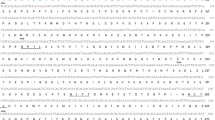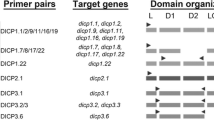Abstract.
Factor I is a novel serine protease that regulates complement activation. Here we report the complete primary structure of two isotypic factor Is isolated from the common carp (Cyprinus carpio), a pseudotetraploid teleost. A carp hepatopancreas cDNA library was screened using two RT-PCR-amplified cDNA fragments encoding part of the carp factor I-like serine protease domain. Two distinct cDNA clones, designated FI-A and FI-B, were isolated. Their deduced amino acid sequences share 75.2% identity with each other. FI-A has a typical factor I-like domain organization composed of two disulfide-linked polypeptides (H-chain and L-chain). On the other hand, FI-B contains a novel sequence of 115 amino acids inserted at the N-terminus of the H-chain. Genomic Southern hybridization suggests that FI-A and FI-B are encoded by distinct genes in the carp genome. Expression analysis by RT-PCR revealed that the major site of FI-A expression is the ovary, whereas FI-B expression is detected mainly in the hepatopancreas at a level higher than that of FI-A. The present data, taken together, suggest that carp have duplicated genes coding for factor I, and FI-B with the novel insertion plays a dominant role in the complement system. In addition, homology search of the fugu genome database using the carp FI-A and FI-B sequences identified a putative fugu factor I gene, which has an exon/intron organization different from that of the human orthologue.







Similar content being viewed by others
References
Chomczynski P (1993) A reagent for the single-step simultaneous isolation of RNA, DNA and proteins from cell and tissue samples. Biotechniques 15:532–534
Goldberger G, Bruns GAP, Rits M, Edge MD, Kwiatkowski D (1987) Human complement factor I: analysis of cDNA-derived primary structure and assignment of its gene to chromosome 4. J Biol Chem 262:10065–10071
Kim M G, Chen C, Lyu M S, Cho E G, Park D, Kozak C, Schwartz R H (1999) Cloning and chromosomal mapping of a gene isolated from thymic stromal cells encoding a new mouse type II membrane serine protease, epithin, containing four LDL receptor modules and two CUB domains. Immunogenetics 49:420–428
Kunnath-Muglia LM, Chang GH, Sim RB, Day AJ, Ezekowits RAB (1993) Characterization of Xenopus laevis complement factor I structure. Conservation of modular structure except for an unusual insert not present in human factor I. Mol Immunol 30:1249–1256
Law SKA, Reid KBM (1995) In: Male D (ed) Complement, 2nd edn. IRL Press, Oxford
Minta JO, Wong MJ, Kozak CA, Kunnath-Muglia LM, Goldberger G (1996) cDNA cloning, sequencing and chromosomal assignment of the gene for mouse complement factor I (C3b/C4b inactivator): identification of a species specific divergent segment in factor I. Mol Immunol 33:101–112
Nagai T, Mutsuro J, Kimura M, Kato Y, Fujiki K, Yano T, Nakao M (2000) A novel truncated isoform of the mannose-binding lectin-associated serine protease (MASP) from the common carp (Cyprinus carpio). Immunogenetics 51:193–200
Nakao M, Fushitani Y, Fujiki K, Nonaka M, Yano T (1998) Two diverged complement factor B/C2-like cDNA sequences from a teleost, the common carp (Cyprinus carpio). J. Immunol 161:4811–4818
Nakao M, Matsumoto M, Nakazawa M, Fujiki K, Yano T (2002) Diversity of complement factor B/C2 in the common carp (Cyprinus carpio): three isotypes of B/C2-A expressed in different tissues. Dev Comp Immunol 26:533-541
Ohno S (1970) Evolution by gene duplication. Springer, New York Berlin Heidelberg
Sahu A, Lambris JD (2001) Structure and biology of complement protein C3, a connecting link between innate and acquired immunity. Immunol Rev 180:35–48
Saitou N, Nei M (1987) The neighbor-joining method: a new method for reconstructing phylogenetic trees. Mol Biol Evol 4:406–425
Sambrook J, Fritsch EF, Maniatis F (1989) Moleculac cloning: a laboratory manual, 2nd edn. Cold Spring Harbor Laboratory Press, Cold Spring Harbor, N.Y.
Schlaf G, Rothermel E, Oppermann M, Schieferdecker HL, Jungermann K, Götze (1999) Rat complement factor I: molecular cloning, sequencing and expression in tissues and isolated cells. Immunology 98:464–474
Sunyer JO, Lambris JD (1998) Evolution and diversity of the complement system of pikilothermic vertebrates. Immunol Rev 166:39–57
Sunyer JO, Zarkadis IK, Sahu A, Lambris JD (1996) Multiple forms of complement C3 in trout that differ in binding to complement activators. Proc Natl Acad Sci U S A 93:8546-8551
Terado T, Nonaka MI, Nonaka M, Kimura H (2002) Conservation of the modular structure of complement factor I through vertebrate evolution. Dev Comp Immunol 26:403–413
Thompson JD, Higgins DG, Gibson TJ (1994) CLUSTAL W: improving the sensitivity of progressive multiple sequence alignment through sequence weighting, position-specific gap penalties and weight matrix choice. Nucleic Acids Res 22:4673
Vyse TJ, Bates GP, Walport MJ, Morley BJ (1994) The organization of the human complement factor I gene (IF): a member of the serine protease gene family. Genomics 24:90-98
Acknowledgements.
This study was supported by grants-in-aid from the Ministry of Education, Science, Sports, and Culture, Japan to M.N. (14560153) and to T.Y. (11460098). S.L.S. is supported by NIH grant GMS090805. We thank Dr. H. Kimura, Shiga University of Medical Science, and Dr. M. Nonaka, The University of Tokyo, for providing sequence information on banded houndshark factor I.
Author information
Authors and Affiliations
Corresponding author
Additional information
The nucleotide sequence data will appear in the DDBJ, EMBL, and GenBank nucleotide sequence database under the following accession numbers: AB072912 and AB072913.
Rights and permissions
About this article
Cite this article
Nakao, M., Hisamatsu, S., Nakahara, M. et al. Molecular cloning of the complement regulatory factor I isotypes from the common carp (Cyprinus carpio). Immunogenetics 54, 801–806 (2003). https://doi.org/10.1007/s00251-002-0518-9
Received:
Revised:
Published:
Issue Date:
DOI: https://doi.org/10.1007/s00251-002-0518-9




